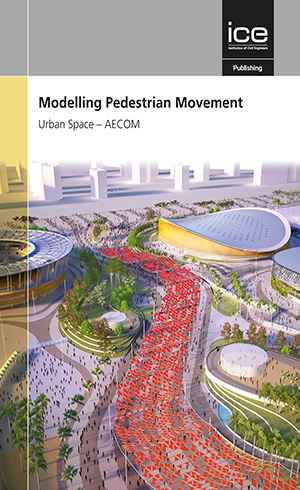Modelling Pedestrian Movement
Modelling Pedestrian Movement, as seen on AECOM's video, provides a detailed introduction to the principles and practices involved in simulating pedestrian and crowd flow patterns. The contents of the book include fundamental research on pedestrian movement; the theories, techniques and tools for pedestrian modelling, and a range of original case studies that illustrate how pedestrian modelling can facilitate design and safety decisions.
Part I on data and techniques guides on data collection, uses of both macroscopic and microscopic simulation model development, and approaches to analysis and interpretation of model outputs. The global case studies in Part II include examples of pedestrian modelling for complex buildings, major events, rail interchanges, airport terminals and public spaces.
Modelling Pedestrian Movement
- shows how pedestrian modelling can be used to validate design, reduce congestion, and facilitate successful operational planning of access, safety and security
- assumes no prior knowledge of pedestrian modelling or pedestrian dynamics
- includes 12 international case studies demonstrating a range of applications.
Modelling Pedestrian Movement
is a unique indispensable guide for transport planners, modelling professionals, urban designers, architects, fire engineers, and students of these subject areas.
The Case Studies are as follows
- Interchange station, Middle Eastern city
- Waterloo Station International Terminal, Wessex Capacity Alliance
- Twickenham Station Redevelopment, Solum Regeneration
- St James’ Park, Newcastle United Football Club
- Rio 2016 Olympic Park Movement Planning
- Urban Realm Assessment, Downtown New Orleans
- Southall Broadway, London Borough of Ealing
- National Pavilion, Astana Expo 2017
- School of Science, Health and Wellbeing
- Shopping-centre case study: Galeries Lafayette, Champs Elysees
- Airport forecourt Pedestrian and vehicle modelling, Middle East
- Hub airport in Southern Africa
Want to know how could pedestrian behaviour impact the safe operation of transport infrastructure in the future? Samya Ghosh and Emmet Ruxton of AECOM’s Urban Space team discuss and consider the impact of COVID-19 in their blog.
Book review
How timely! The authors, presenting themselves as the Urban Space workgroup of AECOM, have made a significant contribution to present the techniques of collecting data and then modelling pedestrian movement. The presentations are clear and easily transferrable to concrete applications. It is then followed by a series of case-studies in various contexts (transport, events, buildings and infrastructure). This would help any civil engineers confronted to urban design, infrastructure planning or any temporary works to find easily their way into this emerging topic.
Philippe Bouillard FICE, Université Libre de Bruxelles, Belgium


No customer reviews